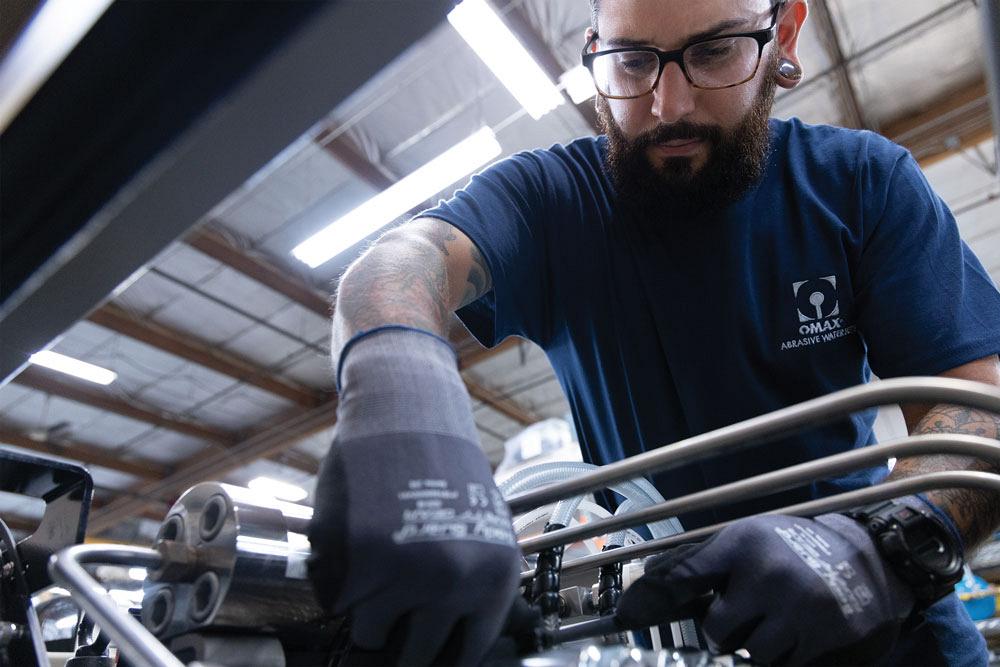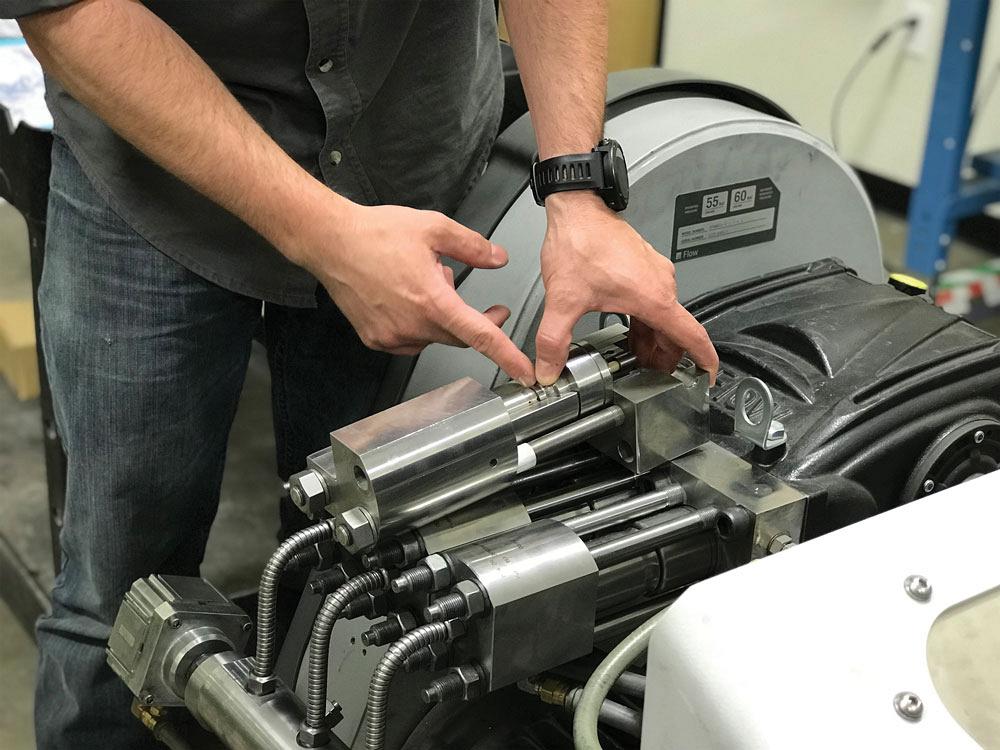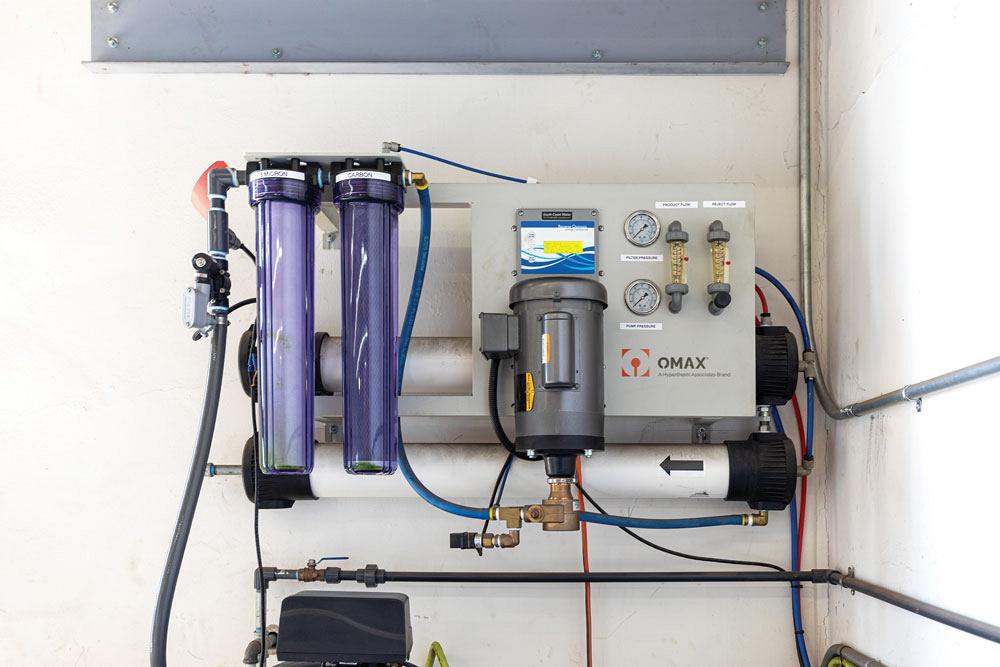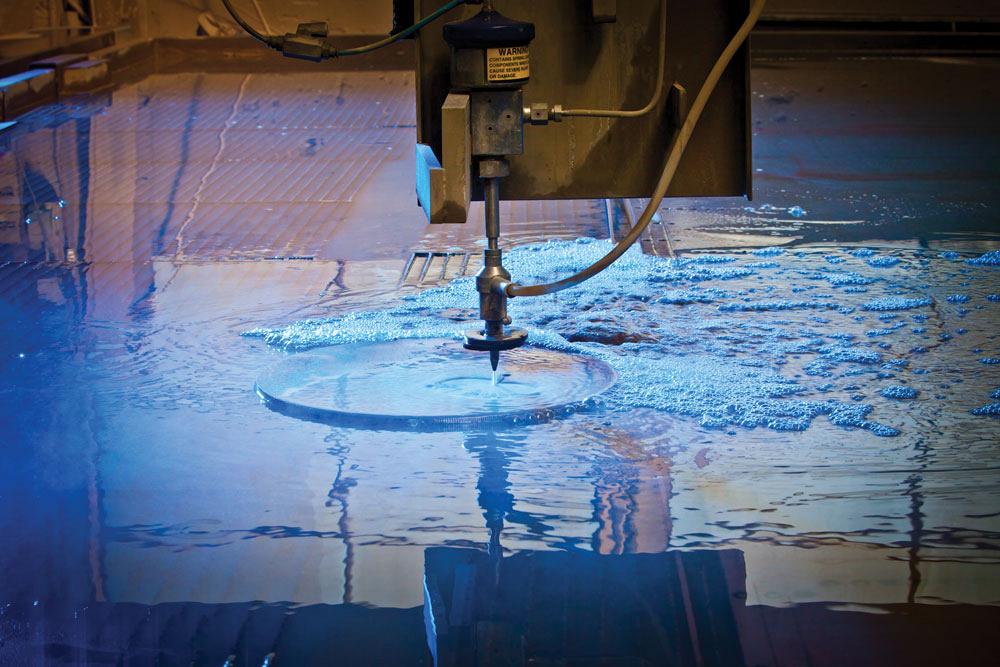Associate Editor
- FMA
- The Fabricator
- FABTECH
- Canadian Metalworking
8 best practices for waterjet optimization
Preventive maintenance and automation can keep waterjets cutting smoothly
- By Lindsay Luminoso
- June 23, 2023
- Article
- Fabricating
Abrasive waterjet machines are fairly mechanically complex systems, and there is a general feeling that these machines are quite messy and maintenance-intensive. But that is not necessarily the case. There are some quick and easy things that all fabricators can do to keep operating costs reasonable and downtime to a minimum.
1. Visually Inspect the Waterjet
One of the easiest things fabricators can do to keep waterjet downtime to a minimum is perform a visual inspection of the equipment.
“As with any piece of equipment, you want to inspect before starting any shift to make sure everything is in good operating condition,” said Arion Vandergon, product marketing manager, at Kent, Wash.-based OMAX. “Power up the system, make sure there isn’t any water leaking from anywhere. Visually inspect the fittings. Walk around the system as it’s operating and look for drips. If there are any, address them right away by turning off the machine and tightening any fitting that might have loosened up.”
Taking the time to inspect the equipment should happen at the beginning and end of any shift to ensure that the machine isn’t left with drips or leaks as it sits idle.
2. Follow a Preventive Maintenance Schedule
Preventive maintenance can be the difference between a waterjet that runs properly and one that sits idle due to failure.
“For whatever reason, preventive maintenance seems to be very black and white in the fact that either shops always follow it, or they never do,” said Scott Ostetrico, product manager, WARDJet, Tallmadge, Ohio. “Some waterjet owners will run the machine until it breaks, while others are meticulous with their maintenance. Generally, smaller businesses are more likely to be meticulous because they understand the value of the capital investment of the machine, and any downtime could be detrimental to workflow. Some larger companies with hundreds of employees don’t necessarily have anyone to take ownership of preventive maintenance and often run the machine until it breaks.”
Most waterjet manufacturers have invested a great deal of time and research development in testing their products, and the results often translate to in-depth knowledge about what it takes to keep the machine optimally running and what needs to be done to maintain that optimization.
“It’s so important to follow the manufacturer’s suggested maintenance checks and schedules provided in the manuals,” said Blake Wortley, product manager—software and systems, Flow Corp., Kent, Wash. “There is a lot of expertise built into those manuals. The users who follow it tend to se a lot of success. Other customers tend to lapse and then won’t get a good result.”
Aside from the standard daily visual inspections, weekly and monthly checks are important. It’s at these stages where fabricators will get more hands-on with the machine, including lubricating the motion system, checking consumables, and just making sure the machine is performing the way it should.
“The more you take care of it on a day-to-day basis, it makes those monthly, weekly, yearly things a lot less cumbersome and a lot easier,” said Wortley.

Running seals to failure may end up damaging some other components within the pump that then require additional downtime to repair. Following a PM schedule can help maintain components together at the right time to minimize overall downtime. OMAX
It’s important to follow a maintenance schedule for the entire system, not just the obvious areas. This includes the cutting head, the pump, the motion system, the frame, hoses, consumables, and just every aspect of the equipment.
“The orifice that shapes the water and the nozzle in the mixing chamber are two components with varying lifespans, depending on the stone,” said Ostetrico. “It’s important to keep track of the cutting hours of your consumables rather than calendar days. As these consumables start to deteriorate and eventually fail, you run a pretty good risk of ruining the material.”
There are a few different types of abrasive-delivering hoses that have a higher tendency to wear. The abrasives will eventually chew through the hoses, affecting abrasive delivery and eventually the cut quality. There are consumables in the pump, like seals and valves, that need to be monitored as well.
“If you operate the system until it breaks, typically there will be additional components that end up failing,” said Vandergon. “Running seals to failure may end up damaging some other component within the pump that then requires additional downtime to repair. Following preventive maintenance can help repair or maintain components together at the right time to minimize overall downtime.”
There’s also new smart technology being introduced into some advanced systems that will help drive preventive maintenance. This technology alerts the operator whenever something needs to be checked or changed, rather then relying on the operator to remember when it was last reviewed.
3. Maintain Water Quality
“Water plays such a crucial role because when you put it into that ultra-high-pressure realm, the dissolved solids or any other pieces can have a big effect,” said Wortley. “We all like to think is water is this inert thing, and in most cases, it is. But when you put it up to 94,000 PSI, it changes. Make sure that you have proper, clean, cold water coming into your machine.”
The manual should provide water quality parameters that will help inform users whether a softener or additional filtration is needed.
For example, water that is too hard will cause calcium and sodium buildup in systems with soft seals within the pump, which will lead to problems. Clean water is essential, and when it comes to total dissolved solids, it is recommended they be between 50 to 150 parts per million.
On the flip side, the water also can be too clean.
“We've had some customers that have had really elaborate filtration systems, and their water is so alkaline that it starts to eat the internals of the pump and the cutting head,” said Ostetrico. “With high alkalinity, you need to add a softener to balance it out a bit.”

Weekly and monthly PM checks are where fabricators will get more hands-on with the machine, including lubricating the motion system, checking consumables, and just making sure the machine is performing the way it should. FLOW Waterjet
4. Ensure Proper Water Temperature
Water temperature also comes into play, especially with ultra-high-pressure systems. When the water is fed through pressurization, it will naturally heat up.
“It's important to start with cool enough water so that it doesn't end up getting to a point that can impact the seals,” said Vandergon. “Water that is less than 70 degrees F or even as low as 60 to 65 degrees F is within that optimal range.”
In warmer climates where water temperature can be a challenge, fabricators can use a chiller system to cool the water to that optimal temperature. Some systems also can pre-treat the water with a softener or with a reverse osmosis system to improve the quality of the water.
5. Keep Table and Surrounding Area Clean
Waterjets are pretty robust machines that often are found in busy fabrication shops. As a result, they and can be exposed to dirt and debris from other shop floor equipment. It is so important to keep the machine free of any sort of buildup.
“And not just for the function of the machine itself, but also when you do have to perform maintenance,” said Wortley. “With routine things like greasing, lubricating, or swapping out components, it adds time if your maintenance technicians have to come in and the equipment is coated in a bunch of grime. Take some time daily to give the machine a quick wipe. You also can use shop air to blow off the cutting head and keep those moving parts free of collection of buildup.”
Most machines have components like mechanical drives that are covered by bellows. While minimal spray will not damage the components, a lot of high-pressure water could.
“There’s a common misconception that because a waterjet shoots at 90,000 PSI, it’s fine to use a hose to spray it with water,” said Ostetrico. “There are places around the cutting head with seals that can withstand water, but there are other places that it’s best not to get water in. Take a damp rag and some Simple Green and wipe it down. That should get the dirtiest parts of the machine clean.”
6. Invest in Automation
A few options are available when it comes to abrasive removal. However, many of the latest waterjet machines offer automation to make it easier.
“The biggest advantage of automatic removal systems is just peace of mind,” said Wortley. “When you're able to automate a process, you're able to reduce the issues and stress of that process.”
An automated system will run continuously while the waterjet operates, meaning that there is no downtime for abrasive removal.

Water temperature and quality are essential to maintaining a waterjet. Some systems can pre-treat the water with a softener or use a reverse osmosis system to improve the quality of the water. OMAX
Most of today’s waterjet tables come with a built-in automated system, but for those that have a table without one, add-on systems are available. The ability to scale up is there. It's always easier to include the automated system in the initial install, but there is the opportunity to upgrade.
“If you use the automated removal system properly, it works really well,” said Vandergon. “At some point, you will still have to drain the tank and clean it out, no matter how much abrasive you pull out, to remove all the little slugs of materials that fall out.”
Beyond abrasive removal systems, there are options on the maintenance side, like automatic greaser or oilers, depending on the application. As part of preventive maintenance, it is recommended that at the month mark, that fabricators grease all bearings, ball screws, rack, pinion, or any other components.
“The only downside is that generally the cartridge lasts only one year,” said Ostetrico. “We often find when we go into shops for service calls, the cartridge sits empty, and the system is unable to grease. These are efficient and effective systems, but the cartridge needs to grease.”
7. Remove Solids Efficiently
It’s important to continuously monitor the solids in the system. Over time, the tank will build up with spent abrasive and the workpiece material that will eventually settle and need to be removed.
“If you keep the tank clean and clean it out during slowdowns, then when you need the machine up and running, it will be available,” said Vandergon.
For shops that do not have an automated system or believe that one is not warranted, there are still some options.
Fabricators can opt for an aftermarket portable abrasive removal system. This option requires no slat removal or digging out. However, the machine will be interrupted during the cleaning process and fabricators need to have access to all sides of the machine for it to be effective.
The other option is manual extraction. Fabricators can either dig out debris using shovels, a backhoe, or excavating equipment. It could be a pump or vacuum truck. One of the advantages is that there is no initial investment cost. However, the machine does need to be idle, and the removal is often time consuming and labour intensive.
“For abrasive application, if the option for an automated system is available, most fabricators take it,” said Ostetrico. “However, there are some companies that choose extraction. Generally, these are more established waterjet customers, and in many cases, they have easy access to an extraction company.”
8. Dispose of Abrasives and Water Appropriately
Once the abrasives and solids are removed from the waterjet table, what’s next?
First and foremost, check with local authorities, whether that’s the landfill or municipal disposal units.
“Some municipalities have very strict requirements and do not accept abrasive debris,” said Vandergon. “Others, it's fine. In some areas of the country, people will use it as backfill to be environmentally friendly rather than sending it to a landfill. It can be used as backfill at construction sites, for example. But the key thing is to make sure there are no hazardous materials within it. If the waterjet is cutting any type of beryllium copper, lead, or materials of that nature, it has to be treated as hazardous waste and disposed of accordingly.”
When it comes to disposal, it’s important to know what is being cut. And while that is important for the abrasive disposal, it also matters for the water disposal. There can be trace amounts of copper or similar materials left in the water after cutting, which means if you are cutting these materials, you have to make plans to capture that water and not just send it down the drain.
Associate Editor Lindsay Luminoso can be reached at lluminoso@canadianfabweld.com.
FLOW Waterjet, www.flowwaterjet.com
OMAX, www.omax.com
WARDJet, www.wardjet.com
About the Author

Lindsay Luminoso
1154 Warden Avenue
Toronto, M1R 0A1 Canada
Lindsay Luminoso, associate editor, contributes to both Canadian Metalworking and Canadian Fabricating & Welding. She worked as an associate editor/web editor, at Canadian Metalworking from 2014-2016 and was most recently an associate editor at Design Engineering.
Luminoso has a bachelor of arts from Carleton University, a bachelor of education from Ottawa University, and a graduate certificate in book, magazine, and digital publishing from Centennial College.
subscribe now


Keep up to date with the latest news, events, and technology for all things metal from our pair of monthly magazines written specifically for Canadian manufacturers!
Start Your Free Subscription- Industry Events
Automate 2024
- May 6 - 9, 2024
- Chicago, IL
ANCA Open House
- May 7 - 8, 2024
- Wixom, MI
17th annual Joint Open House
- May 8 - 9, 2024
- Oakville and Mississauga, ON Canada
MME Saskatoon
- May 28, 2024
- Saskatoon, SK Canada
CME's Health & Safety Symposium for Manufacturers
- May 29, 2024
- Mississauga, ON Canada





















